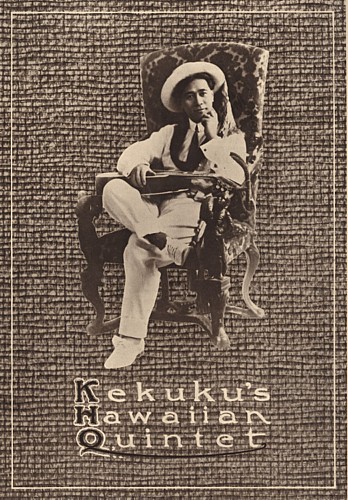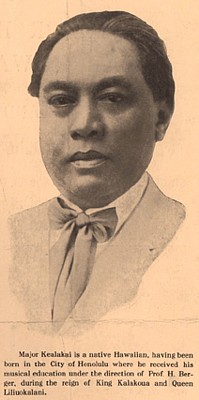Part of the IaGenWeb Project






 There is no music in all this world that has gained for itself such rapid and favorable popularity as the music of
Hawaii. This group of Islands in the middle of the Pacific Ocean, thousands of miles away from any musical center, has
produced a wealth of pleasing and soothing melodies. The fascination of these plaintive airs has attracted hundreds and
hundreds of musical souls in every land.
There is no music in all this world that has gained for itself such rapid and favorable popularity as the music of
Hawaii. This group of Islands in the middle of the Pacific Ocean, thousands of miles away from any musical center, has
produced a wealth of pleasing and soothing melodies. The fascination of these plaintive airs has attracted hundreds and
hundreds of musical souls in every land.
NOTE: At this time Hawaii was NOT a State of the Union of the United States.
The formation of Hawaiian melodies dates to its orgin from the period of the early invasion of the missionaries. Their hymns were translated into the native language and congregations were taught to sing them. The native soul, which was instinctively full of rythem was soon inspired, and they apprehended these variations of pitch, modulating therefrom the present much heralded melodic construction. Orignally the songs had time and rhythm but no melody. They were more like chants accompaied by the beating of gourds and drums.
There were male and female chanters who would sing in relays, hence all the male voices would strive to reach the same pitch, and likewise the women, at a higher interval. From that other intervals were added in such manner as was most pleasing to them at that time, which usually ran in a short minor. It graduated from that into the more correct groupings such as the missionaries had taught them, and tody [1916] composers are quietly adopting the more advanced ideas of modern harmonizing.
As to the string instruments, the native Hawaiian originally had what was called the "Ukeke," and that was just an ordinary piece of curved wood with two gut strings stretched tightly across with no set tuning in particular. This they placed one end at the mouth, holding the other end out in either hand, and with a straw they strummed gently across the strings. There is hardly any tone on one of these instruments, simply a monotonous weird sound very much like that of a Jew's harp. the Ukele was the first of a series of stringed instruments which the ingenuity of the younger generation of Hawaiians has developed into what is popularly known as the Ukulele.
The Ukulele is a facsimile of the old Spanish guitar, but diminutive in size. It is largely made from Koa or Kou, a species of mahogany grown only in the Hawaiian Islands.
This charming and sweet-toned instrument is one that is dearly loved by every Hawaiian. In their sweetest melodies and Hula (dance) music, the Ukulele plays an important part, being used mostly as an accompaniment. Although solos and selections can be played on them, or fascinating obligatos and the like, yet the real beauty of the instrument is the gentle strumming across the strings in such a manner as to bring fourth its liquid tones clearly and distinctly.
The steel guitar - so called because it is played with steel picks attached to the fingers - is the latest addition to this series of instruments, having been brought out only about twenty years ago. It is heard at its best when used in combination with the Ukulele.
 The KEALAKAI Orchestra is
made up of artists in the used of both these instruments. Their playing has been enjoyed by music lovers in all the
leading cities of the Pacific Coast and Middle West.
The KEALAKAI Orchestra is
made up of artists in the used of both these instruments. Their playing has been enjoyed by music lovers in all the
leading cities of the Pacific Coast and Middle West.
Mekia ("major" in Hawaiian) KEALAKA'I (1867-1944) was so named because his father was a sergeant major, emerged from poverty to become one of the most respected musicians of his day, as an instrumentalist, composer, troubadour and finally as the bandmaster of the Royal Hawaiian Band.
His musical training began in reform school, where he had been sent at the age of 12 for truancy. Captain Henry BERGER taught music there, and the boys who showed talent were recruited into the Royal Hawaiian Band. Mekia KEALAKA'I was one of those boys. He spent many hours learning harmony and how to play trombone, flute and piano, and became one of BERGER'S favored pupils.
Although he was admitted into the band as a trombonist, it was Mekia's flute playing on a U.S. mainland tour in 1895 that so impressed John Pilip SOUSA, that Mekia was invited to join SOUSA'S band. The March King once remarked that Mekia was "the greatest flutist I have ever heard." For more than 20 years KEALAKA'I toured the U.S. and Europe; his three years in London perfoming at athe Palladium, Savoy and Crystal Palace helped to spark the interest in Hawaiian music which still exists in England.
KEALAKA'I's composing skills were such that the could compose on the spot by request. "Eo E Kalanikaulilua" was written on the death of King Kalakaua in 1891; "Ko Leo" was written for Queen Lili'uokalani. His best known song is "Lei 'Awapuhi" ("Ginger Lei") written on a train ride in 1893 from the Buffalo Exposition in New York in 1902. The sight of a daisy field inspired Mekia to write about Hawaii's sweet smelling ginger. "Lei Awapuhi was one of the few songs composed by a Hawaiian that became popular in the U.S. before it was ever heard in Hawaii.
Mekai was one of the Hawaiian music pioneers who helped incite a world-wide craze for Ukulele and Hawaiian music. His troupe joined the Keith Vaudeville circuit what ended with engagements in San Francisco and Los Angeles in the early 1900's.
Mayor John H. WILSON called Mekia KEALAKA'I back to Honolulu in 1920 to lead the Royal Hawaiian Band because Hawaii "needs you to help preserve her music."
Under Mekia's strong leadership, the band kept its Hawaiian character, Hawaiian membership and emphasis on Hawaiian songs. Mekia composed many songs for the Royal Hawaiian Band. He also wrote an Ukulele instruction book in 1914.
Mekai KEALAKA'I did in April of 1944, and was interrred at Diamond Head Memorial Park, Honolulu.
In 1996, he was inducted into the Hawaiian Music Hall of Fame.
From reform school to Bandmaster, Mekai served for 40 years in the Royal Hawaiian Band.
 KEALAKAI'S Playbill |
 KEALAKAI'S Ukulele Book |

SOURCES:
University of Iowa Libraries/digital.lib.uiowa.edu/tc
Hawaiian Music Hall of Fame
Transcription by Sharon R. Becker, September of 2011.

Ringgold Co. IAGenWeb Project All rights Reserved. |